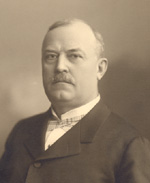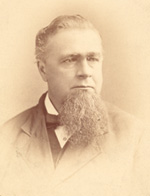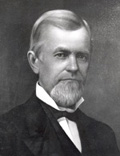| Home History Biographies Faculty & Alumni Timeline Related Articles Related Links |
“Reminiscences of the Old Days” by James H. Prothero, ca. 1929
REMINISCENCES OF THE OLD DAYS Hamilton defines “Memory” as “the faculty of retaining knowledge in mind but out of consciousness.” After nearly forty years removal from the scenes of my student days, in an environment where those days were seldom if ever mentioned, I find that many details and perhaps some facts of importance which occurred during that period are more or less hazy and indefinite, and still “out of consciousness.” Coming as I did, from the west, where horses and cattle, lumber mills and great forests of immense trees were more familiar to me than cities, St. Louis seemed a strange and crowded place. The cable was replacing the horse car and the Exposition Building located between 13th and 14th on Olive Street was to me the wonder of the age. The mechanical arts there displayed, the art gallery and Gilmore’s Band being the chief attractions that interested me most of all.
I arrived in St. Louis on an evening in September 1885, too late to inspect the Dental School. At 8 o’clock the next morning, I found Dr. H. H. Mudd, our Dean of honored memory, in his office. Although when opportunity presented, I had been diligent at school, I had no educational credentials to offer, whereupon Dr. Mudd then and there proceeded to give me an oral examination. This covered a wide range of subjects, from an inquiry into my antecedents, various common school branches and finally my reason for choosing dentistry as a profession. I never knew what grade he assigned but I do know that, although young and robust, heart failure nearly ended my career on that occasion. Finally his sphinx-like expression relaxed into a smile, the tuition fee was accepted and he issued some twelve or fourteen cards of admission to the various lecture courses of the college. Those cards are still among my highly prized keepsakes. Although each student was permitted to attend any lecture, the Juniors, as the first year men were called, confined their efforts to the dental subjects and the four fundamental branches of medicine, viz., anatomy, physiology, chemistry and materia medica. The men with whom I was thrown most closely in contact as a Junior, were Drs. Mudd, Fuller, Eames, Harper, Alleyne, Lytton, Fry, Baumgarten and Miller, Superintendent of the Infirmary, and Special Lecturers, Morrison, Keith, Patrick and Judd. Instruction on dental subjects were most interesting to me, perhaps because that line of endeavor seemed the shortest road to independent effort, and that applied to the classes in general. Dr. Mudd’s lectures on surgical anatomy and his work in clinical surgery were always interesting and instructive. His reminiscences of cases from practice were very entertaining and held the attention of the class to a remarkable degree.
Dr. Fuller’s lectures on operative dentistry were up to date and perhaps ahead of accepted practices of that day. He usually demonstrated with various instruments, the subject under discussion. Great stress was laid on the conservation of tooth structure, particularly the saving of enamel in the anterior teeth, to avoid an undue display of gold. Sets of hand pressure corkscrew pluggers were exhibited to illustrate how cavities could be filled from the lingual surfaces without the necessity for labial access. Dr. Black’s rules for cavity preparation and cavity nomenclature did not appear until a number of years later. In the light of present advancement, I wonder at not how little but how much Dr. Fuller accomplished considering the handicaps of those days. Dr. Eames was Professor of the Institutes of Dental Science, whatever that was. His lectures covered various subjects in dental anatomy and histology of the head and teeth, dental materia medica, and many practical problems occurring in routine office work. He would frequently devote ten or fifteen minutes of each lecture hour in quizzing on the subject of the previous week. One day he described the sphenoid bone. Anticipating a quiz on that bone, my roommate Dr. Hart and I spent the greater part of one night consulting Gray’s Anatomy on the subject. Next morning in quiz, he asked me what was transmitted through the sphenoid fissure when I immediately repeated the formula from Gray’s which strangely enough I still retain fairly well after these many years: “The third, the fourth, the ophthalmic division of the fifth, and the sixth cranial nerves, some filaments from the cavernous plexus of the sympathetic, the orbital branch of the middle meningeal artery, a recurrent branch from the lachrymal artery to the dura mater and the ophthalmic vein.” The doctor said, “you must have been studying young man,” and with due, and I hope becoming modestly, I answered in the affirmative. The result was a closer acquaintance with the Doctor and an invitation to go to his office occasionally which meant much to a beginner in a strange field. Dr. Harper seemed to have a liking for the metallurgical side of prosthesis or mechanical dentistry as it was then called. The making of dies and counterdies, the swaging of denture bases and the casting of cheoplastic lowers were the principal subjects stressed, while toward the last of the term he worried us with problems in the reduction of various carats of gold. Dr. Morrison demonstrated the making and tempering of steel instruments of regular and special forms. The instruction he imparted has been a source of satisfaction, value and pleasure to me throughout these many years. Dr. H. H. Keith constructed a continuous gum denture before the class which in those days was a considerable task. The coke furnace was the only means of baking such cases then, so the fire was lighted about noon and kept burning continuously until 8 P.M. when Dr. Keith appeared and the show began, and after that until the case was completed. The denture was subjected to three bakings and to entertain us during the various intervals, Dr. Keith told stories and related incidents of office practice. Altogether an enjoyable evening was had by all and we went home at about 3 A.M. filled with high hopes and great ambitions. Dr. Patrick with his flowing iron gray locks, prince Albert coat, with two gold buttons and three inch strap connecting them, was an impressive figure. He was a man of marked ability and his lectures were much appreciated. As I now recall, he lectured on embryology.
Dr. Judd whose health was somewhat impaired, came before us but once. That occasion impressed us with his breadth of learning and scholarly attainments. He was an intellectual leader, far ahead of the procession and withal, most modest. He was the leading personage in the organization of our School and was its first Dean. Dr. Alleyne was a fine type of the old school, polished gentleman, kind hearted, precise and accurate in his manners and speech. He was thorough in his knowledge of materia medica yet able to recognize its limitations. On one occasion, in referring to the mental effects of administering remedies he said, “Gentlemen, we give medicine to our patients to amuse them and divert their minds, nature does the healing.” Dr. Lytton stressed the fact that Nordhausen sulphuric acid was merely H2S04 with the radical S03 added. He also showed us a rare specimen of aluminum about the size of half a lead pencil and carefully preserved in a glass tube, peculiar because of its extreme lightness and its non-oxidizable properties but too expensive for practical use. Dr. Baumgarten emphasized the fact that fibrin and fibrin ferments in the blood caused coagulation and that a disturbed balance of these constituents might result in fatal hemorrhage following the extraction of teeth, surgical operations or traumatic injuries. Dr. H. C. Miller, now dean of the North Pacific Dental School was a careful, exacting and conscientious demonstrator whose efforts supplemented the teaching of the various professors in a practical and efficient way. To him we were all indebted for his kindly help and advice. His hobby was the construction of celluloid dentures by the dry process. At the end of the session of 1885-6 I departed for the west to recoup my scattered fortune, in other words, to earn enough money to carry me through the second term. Three years elapsed before I resumed school work. What occurred in that interval is another story but a very interesting one with many thrills and some sad as well as profitable experiences. In the fall of 1889 thirty-three seniors were matriculated for the final term, our present worthy dean and myself being included in the class. Dr. Kennerly was then Superintendent of the Infirmary and we found him very likable, proficient and accommodating. Dr. Bartlett whose long experience in the prosthetic field was appointed our demonstrator and I take pleasure in here publicly acknowledging that much of what little success I may have attained in prosthetic dentistry, was due to my association with him. Within a year after graduating he contributed a paper to the Archives of Dentistry, on “the abuses in crown and bridge work” which some of the more recent writers might read with profit. In fact some are fast waking up to the truth of the facts he there presented. The alumni should be proud of his professional standing and attainments and his long continued efforts in behalf of our school, through adverse as well as prosperous years. Few changes had occurred in the Faculty of the school between ’85 and ’89. Dr. Senseny had succeeded Dr. Baumgarten in the chair of Physiology, and Dr. Friedman was assistant and quiz-master in Chemistry and no better nor more inspiring quiz-master ever appeared before any class than our friend Jake as the boys called him. He encouraged those who tried to grasp the subject and he made life miserable for those who were indolent. Our class was an average one and came through with average grades, Dr. P. H. Morrison leading and taking the gold medal for best examination marks.
This is the thirty-eighth anniversary of the graduation of that class. I feel pride in being an alumnus of the old Missouri Dental School and a member of the class of 1890. Great credit should be accorded the Missouri State Dental Association for making possible the organization of the Missouri Dental College for it was through the efforts of that Society that the school was founded. That the school from its first inception down to the present moment has maintained the highest standards and been a leader among schools, is self evident. Now with a new home almost ready for occupancy and the school having become an integral part of a great university, the traditions of the past are likely to be enhanced and probably exceeded. If the younger members of the Alumni need any inspiration to spur them on to worth-while accomplishments let them review the list of outstanding graduates of the school and others who have at one time or another been and are now teachers in this great institution. The list is too extensive to enumerate all, but a few of the older names can appropriately be mentioned, namely, Judd, Black, Gilmer, Forbes, Peebles, Patrick, Morrison, Fisher, McKellops, Bowman, Eames, Harper and many others. Some one has said “Old men Dream Dreams. Young men see Visions.” The world’s progress has been made not by dreaming Dreams but by seeing Visions. Dreams are concerned with the past. Visions deal with the future. It seems to me that the Faculties of Missouri Dental College from the school’s first activities down to the present young alert and vigorous one have seen and are seeing visions and those visions are the advancement of the dental profession, the conservation of health, and the betterment of mankind. That the spirit of these visions has been imparted to many of the students of our school is evidenced by the fact that considering the number graduated our alma mater can furnish the largest list of any school in the country of men who have occupied positions as deans and professors of Colleges, Members of State Examining boards, Officers and members of committees of Dental Societies and writers of distinction. As a loyal son of our alma mater I rejoice with all of you on the acquisition of a handsome, commodious, and modern sanitary building in which the school may function with greater efficiency and preserve the traditions of the past.
|
|||||||||||
| Home | History | Biographies | Faculty & Alumni | Timeline | Related Articles | Related Links | ||||||||||||
|
 |




